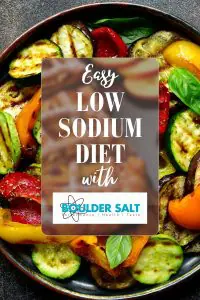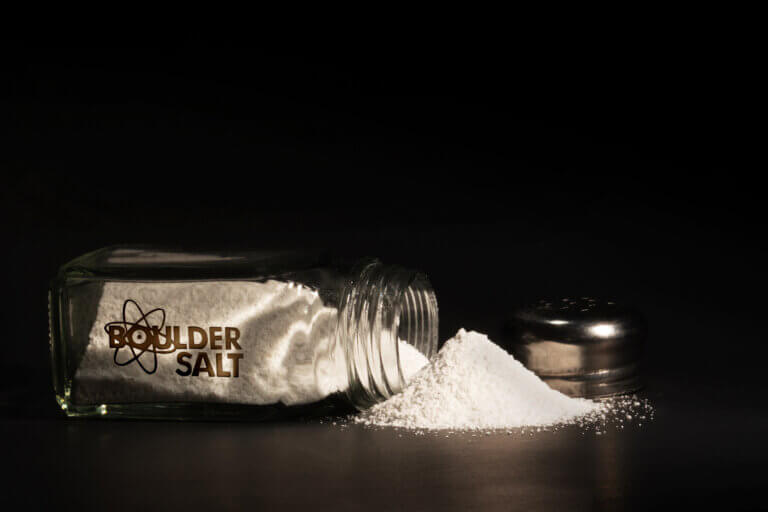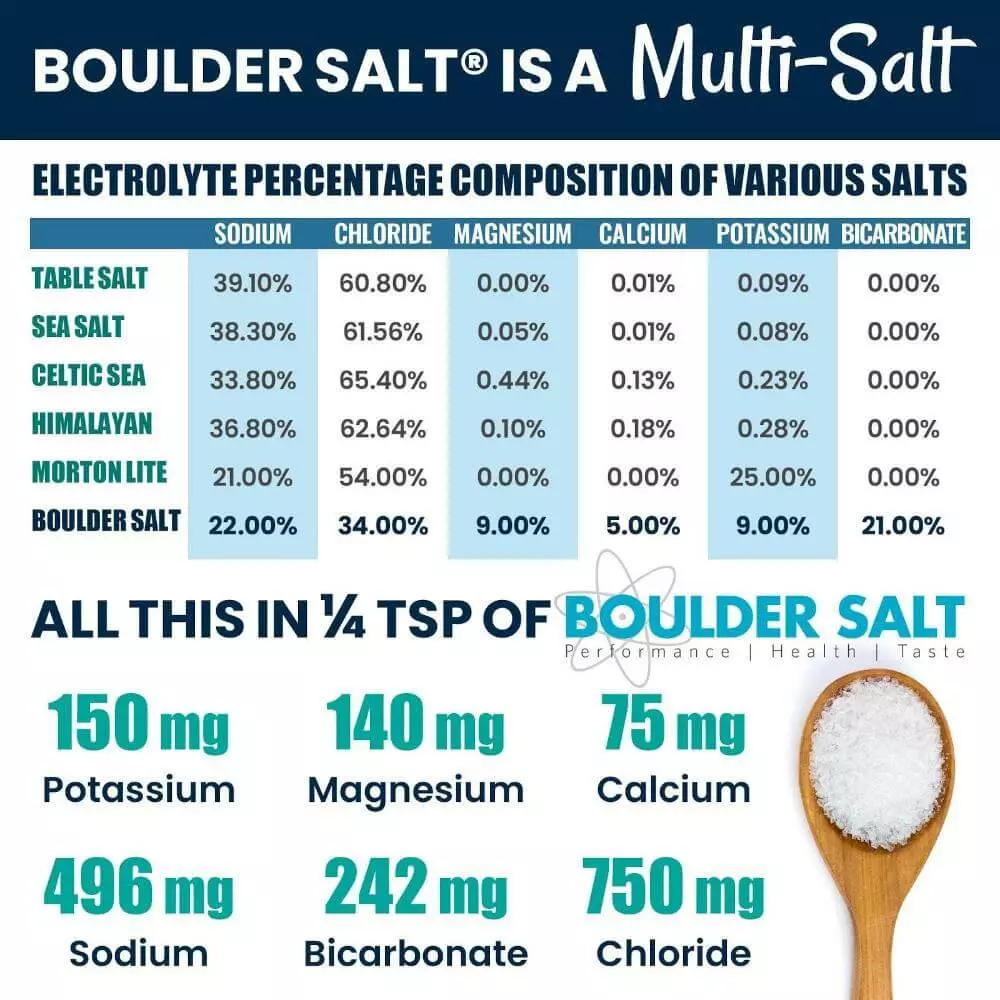
Low Sodium Diet Ideas Any Diet is Low Sodium with Boulder Salt! Are you looking for low sodium diet ideas and recipes

Boulder Salt from bouldersaltcompany.com is the best low-sodium salt on the market today! Not only is it low in sodium, but it is also nutrient-dense multi-salt enjoyed by athletes and home cooks worldwide. Boulder Salt contains 40% less sodium per serving than conventional table salt.
Salt substitutes are made by exchanging some or all of its sodium with potassium, magnesium, or another mineral.
People often use the phrases “salt” and “sodium” interchangeably. However, they are different. Salt (sodium chloride) is a readily available compound found in nature. Sodium is a mineral and chemical that makes up salt. (source)
While salt is vital to the functioning of the human body, too much of the wrong kinds of salt can wreak havoc on your body: mainly your cardiovascular health. This is why choosing the correct low-sodium salt is important to your health.
Table salt is the most common salt people use. It is used primarily as a seasoning.
Salt is “hygroscopic” which means it attracts water. To ensure it will remain free-flowing when exposed to the atmosphere, small quantities of sodium aluminosilicate, tricalcium phosphate, or magnesium silicate are added to table salt.
Iodized salt—that is, salt to which small quantities of potassium iodide have been added—is marketed in areas where iodine is not in abundance.
The problem with these kinds of salts is purity. While they may be considered high purity by basic standards, they may be different from the purest salt on the market when compared to high standards. These salts like Morton salt, table salt, pink salts, and sea salts contain toxic heavy metals that are harsh on the body. Are you seeking a healthy salt alternative?
What is low sodium salt?
It all comes down to regulatory guidelines set by the FDA.
Here’s a list of average sodium claims:
Here is a list of some typical salts and their sodium levels ranging from lowest to highest.
The main benefit of low sodium salt is a positive impact on your cardiovascular health. Most Americans consume too much salt, leading to common cardiovascular issues. The benefits of low sodium salt also increase the number of minerals and electrolytes in your diet without a harmful excess of sodium.
Eliminating excess sodium from your diet can improve blood pressure levels which can reduce your chances of hypertension, heart disease, and stroke.
More than 70% of dietary sodium comes from packaged restaurant Foods. The CDC says this may be the reason why Americans consume an average of 3,400 mg daily.
Yikes! That’s a lot of sodium. Are you aware of how much sodium you are consuming each day? It pays to be aware.
Over 600,000 people died of cardiovascular-related illnesses in 2020.
“Elevated blood pressure, or hypertension, is the leading cause of preventable deaths globally.” (source)
Many people are turning to alternative diets low in sodium for various reasons mainly to improve cardiovascular health, as recommended by the medical community based upon research. A Low sodium diet has a positive impact on health.
Eating a lot of high-sodium foods found in packaging can increase feelings of hunger. not all foods high in sodium taste salty, so it’s important to read food labels. a low-sodium diet could help you reduce weight as well as reduce the risk for cardiovascular-related illnesses.
FDA guidelines demand food labels have 140 mg of sodium or less per serving to claim low sodium. The food must have 35 mg of sodium or less per serving to qualify as very low sodium and 5 mg of sodium or less per serving to qualify as salt and or sodium free.
If food is labeled reduced sodium, it must have at least 25% less sodium than the regular alternative. To be considered light in sodium or lightly salted on the label requires the food to have at least 50% less sodium than the regular option.
Unsalted or no salt added suggests no sodium was added during processing, but the food may not actually be free from sodium.
Sodium and potassium are electrolytes and help your body maintain fluid and blood volume.
Replenishing your body with electrolytes can prevent muscle cramps from exercise. This is part of why you’ll see athletes rehydrate with electrolyte-rich drinks. Boulder Salt makes an amazing electrolyte-rich recovery drink.
Cooking with salt usually leads to lower sodium intake than consuming packaged and/or prepared meals at restaurants.
Your grocery store is packed with foods labeled reduced sodium and light sodium. This doesn’t mean that they’re actually low in sodium.
For example, a carton of beef stock that reads “25% less sodium” still has 524 mg in just 1 cup. It’s only lower in sodium compared with standard beef stock, which has over 790 mg of sodium in one cup.
Smart approach: adding your own low-sodium salt to the fresh foods you cook can help you take back control of your health. Cooking simple fresh meals and adding Boulder Salt to taste is a great way to lower your sodium intake without compromising flavor.
Lowering your sodium intake is as simple as choosing a low-sodium salt brand like Boulder Salt.
The guidelines below could help you lower your sodium intake:
Boulder Salt is a great alternative because ¼ of a teaspoon contains 40% less sodium than table salt, is incredibly clean, with nutrient-dense mineral content. It has a great salty taste, ensuring you’re not loading on teaspoon after teaspoon to get the flavor you’re looking for.
Always consult with a qualified healthcare professional when choosing to regulate your health. Potassium in some salt substitutes could pose a problem for some people. Excess potassium can be harmful to people with kidney problems or those who take medications that cause potassium retention, like ones used to treat high blood pressure and congestive heart failure.

More to explore

Low Sodium Diet Ideas Any Diet is Low Sodium with Boulder Salt! Are you looking for low sodium diet ideas and recipes

Mountain View Welding does excellent work!
We make the highest recommendation for Loren Tonsing and the staff at https://mountainviewwelding.com Mountain View Welding does excellent work! Excellent communication to

Boulder Salt is in stock at The Raw Store!
Where in the world is Boulder Salt? This time the news is that Boulder Salt is stocked at The Raw Store in